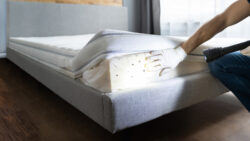Imagine waking up to itchy red welts on your skin, only to find out that your home has been invaded by bed bugs. These tiny pests are not just a nuisance; they can quickly escalate into a full-blown infestation if not dealt with promptly and effectively. Fortunately, with the right knowledge and strategies, you can protect your home and family from these unwanted intruders. In this guide, we’ll delve into the signs of bed bugs, how they get into your home, effective treatment methods, and essential tips for bed bug control.
Signs of Bed Bugs
Bed bugs are masters of stealth, often making them difficult to detect until the infestation has already taken hold. However, there are several telltale signs to watch out for:
- Visible Bugs: Adult bed bugs are about the size of an apple seed and are reddish-brown in color. While they are relatively small, they can still be spotted with a keen eye, especially in areas where they congregate.
- Bite Marks: Bed bug bites typically appear as small, itchy red welts on the skin, often arranged in clusters or lines. These bites can be found on any part of the body but are commonly found on exposed areas such as the face, neck, arms, and hands.
- Blood Stains: After feeding, bed bugs may leave behind small blood stains on your sheets, pillowcases, or mattress. These stains are a result of accidentally squashing the bugs while they feed.
- Dark Spots: Bed bugs excrete waste after feeding, which appears as dark spots or smears on your bedding, mattress, or nearby furniture.
- Musty Odor: In severe infestations, bed bugs may emit a musty odor, often described as sweet or unpleasant.
Ways Bed Bugs Get into Your Home
Bed bugs are notorious hitchhikers and can easily find their way into your home through various means:
- Used Furniture: Bringing home secondhand furniture, such as mattresses, sofas, or chairs, can introduce bed bugs into your living space. Always inspect used furniture thoroughly before bringing it indoors.
- Travel: Bed bugs can hitch a ride on your luggage, clothing, or personal belongings when you travel and infest your home upon your return.
- Guests: Visitors staying overnight may unknowingly bring bed bugs with them, particularly if they have recently stayed in an infested accommodation.
- Shared Spaces: Living in close proximity to others, such as in apartments, dormitories, or hotels, increases the risk of bed bug transmission from neighboring units.
Bed Bug Treatment Methods
When faced with a bed bug infestation, swift and decisive action is crucial. While there are various treatment methods available, it’s essential to choose one that is effective and safe for your home and family. Here are some commonly used bed bug treatment methods:
- Heat Treatment: Bed bugs are highly sensitive to heat, making heat treatment an effective way to eliminate them. Professional pest control companies use specialized equipment to raise the temperature in infested areas to levels lethal to bed bugs, effectively eradicating the infestation.
- Fumigation: Fumigation involves the use of gaseous pesticides to penetrate cracks, crevices, and other hiding spots where bed bugs may reside. This method is typically conducted by licensed professionals and requires vacating the premises during treatment.
- Chemical Treatments: Insecticides specifically formulated for bed bug control may be applied to infested areas, such as baseboards, furniture, and cracks and crevices. It’s essential to follow the manufacturer’s instructions carefully and consider consulting a professional for safe and effective application.
- Steam Treatment: Steam can effectively kill bed bugs and their eggs by exposing them to high temperatures. Steam treatment is particularly useful for targeting bed bugs hiding in mattresses, box springs, upholstery, and other fabric surfaces.
Tips for Bed Bug Control
Prevention is key when it comes to controlling bed bugs. Here are some practical tips to help safeguard your home against infestations:
- Inspect Secondhand Furniture: Before bringing used furniture into your home, thoroughly inspect it for signs of bed bugs. Pay close attention to seams, folds, and crevices where bed bugs may hide.
- Be Cautious When Traveling: When staying in hotels or other accommodations, inspect the room for signs of bed bugs before unpacking. Keep luggage elevated and away from the bed, and wash clothing in hot water upon returning home.
- Encase Mattresses and Box Springs: Encasing mattresses and box springs in specially designed bed bug-proof covers can help prevent bed bugs from infesting these items and make detection easier.
- Reduce Clutter: Minimize clutter in your home to eliminate potential hiding spots for bed bugs. Keep bedrooms tidy and organized, making it easier to spot signs of infestation.
- Seal Cracks and Crevices: Seal cracks and crevices in walls, baseboards, and furniture to prevent bed bugs from hiding and laying eggs in these areas.
Dealing with a bed bug infestation can be a daunting task, but with the right knowledge and strategies, you can protect your home and family from these persistent pests. By familiarizing yourself with the signs of bed bugs, understanding how they get into your home, employing effective treatment methods, and implementing preventative measures, you can effectively control and eliminate bed bugs from your living space. Remember, when faced with a significant infestation, don’t hesitate to seek assistance from a professional bed bug control company near you to ensure thorough eradication and peace of mind.



